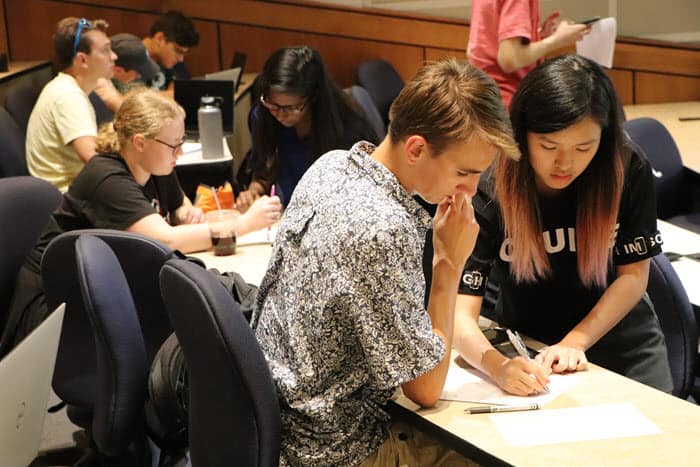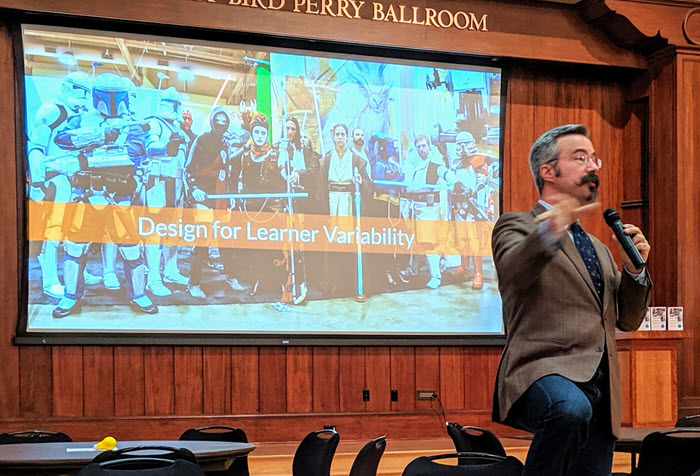By Doug Ward
Watching David Johnson’s class in digital logic design is a bit like watching synchronized swimming.
After a few minutes of announcements, Johnson and half a dozen GTAs and undergraduate teaching fellows fan out across an Eaton Hall auditorium as 60 or so students begin to work on problems that Johnson has assigned.

A hand goes up on one side of the room. Johnson approaches, and students around him listen intently as he asks questions and quietly offers advice. Across the aisle, a group of four young men confers about the problem, looking things up on laptops, writing down notes by hand, erasing, writing again, and sharing ideas. A few rows ahead, two young women point at the problem on the screen at the front of the room. They confer, take notes, and confer more. Across the room, hands go up and, one by one, the class assistants approach, offer their help and then search for more raised hands.
“We’re always busy helping someone,” Johnson said.
Similar scenes have increasingly played out across the university – and across the country – as a growing number of instructors, primarily in STEM fields, have hired undergraduate teaching assistants to work in their classes. The undergrad TAs are just one example of how colleges and universities have elevated the importance of peer learning as part of their efforts to retain students and to help them move toward graduation.
Many educational roles
At KU, those efforts extend into many areas. First-Year Experience, honors, pharmacy and business are among the programs that use peer mentors. The Undergraduate Advising Office has a team of peer advisors who, among other things, help students navigate choices of classes and majors, and help them find campus resources. As anxiety and depression have increased among students, Counseling and Psychological Services has created a peer educator program to work with students on mental health.

The university’s Supplemental Instruction program is also growing and now has peer leaders working with two dozen courses. Those peer leaders have successfully completed the course they are helping with. They lead sessions in which students review course material, prepare for exams, work on study skills, and offer support to one another throughout a semester. That approach, which started at the University of Missouri-Kansas City, has been found to improve grades, retention rates and, ultimately, graduation rates.
Peers have always played a role in learning, and they have long been involved in writing programs, tutoring and review sessions. The use of large numbers of undergraduate assistants in classes is relatively new, though, and is tied to a growing use of flipped classes, active learning, and in-class problem-solving. Over the past five years or so, KU instructors in such fields as geology, biology, chemistry, physics, and engineering have hired undergraduate assistants to work in their largest classes. Those assistants do such things as monitor online discussion boards, help with labs, proctor exams, and hold office hours. A pre-semester training program was started two years ago for undergraduate assistants in STEM courses, allowing the assistants and instructors to gain a better understanding of how to work together.
Undergraduate assistants have been crucial in transforming large lecture courses into hubs of active learning. Coordinating with instructors and graduate teaching assistants, they monitor groups or sections of a classroom, answer questions, offer praise, and through their interactions with students, make large courses more personal. Like students who lead Supplemental Instruction sessions, the undergraduate assistants in large classes have recently taken the course, so they understand the flow of the class, the course material, and the areas where students are most likely to struggle.
As they help their peers, they hone their own understanding of course material, improve their communication skills, and gain experience working with groups of people. That deeper understanding helps prepare them for upper-level classes as well as medical school exams, internships and graduate school. Most rely on the money they earn to help pay their college bills. Nearly all report a sense of satisfaction from the experience.
“When you see someone finally get it, it’s really cool,” one undergraduate assistant said at a recent training session.
Zero lecture time
Johnson has used graduate teaching assistants, Supplemental Instruction assistants, and undergraduate teaching fellows (as the assistants are known in engineering) to make dramatic changes in his classes. With the help of Molly McVey, a post-doctoral teaching fellow in engineering, Johnson flipped a course in which he was lecturing about half of class time. They created online materials that helped students prepare for in-class problem-solving and hired undergraduate fellows to help in the classroom. When the flipped version debuted last year, lecture time had dropped to nearly zero.
“The only time they really hear me speak is if I have an announcement, usually to remind them of a test,” Johnson said.
Johnson first tried the flipped approach during a summer computer science camp for high school students, and he was surprised by how much more students learned. So he began to transform EECS 140, which he described as a gateway course required of all students in electrical engineering. He received a course transformation grant from the Center for Teaching Excellence and worked with course designers and video specialists at the Center for Online and Distance Learning to create online materials. He had the undergraduate assistants create the in-class problems, which he described as “nearly perfect” because they require considerable thought but can still be completed during class time.
During the first week, students aren’t sure what to make of the hands-on approach, but that hesitancy quickly disappears as they adapt to the in-class problem-solving.
“The first class they were just sitting there waiting,” Johnson said. “I explained to them again that they could start working. By the third or fourth class, they were already asking questions even before the class started.”
The questions continue throughout the class period, and Johnson and the student assistants are constantly on the move. The constant interaction has helped Johnson better connect to the class.
“When I walk around and talk to students, I really understand what they don’t understand,” Johnson said. “That really helps me do a better job.”
Students are free to leave class once they complete the day’s problems, but many stay for the entire period. Some who finish early work on the next online module, knowing they can get help if they have questions. Others like to stay and help their peers.
Improved learning and a sense of satisfaction
Learning has improved significantly in many areas of the class, and the number of students who drop or fail has fallen. The approach isn’t perfect. Johnson said there was a dip in some areas on the last of the four exams he gives. By the end of the semester, though, many students know that their grades won’t change much regardless of how they do on the last exam, so they don’t approach that exam with the same seriousness they do earlier work, Johnson said.
During class, though, the students are focused and engaged. A hand goes up at the back. An undergraduate teaching fellow kneels, listens and offers advice. A hand goes up in front, in the center, on the far side of the room. Johnson moves from table to table, student to student.
“Students always think it’s easy for an instructor to do that,” Johnson said. “For me, it’s a lot harder to go around and explain something to someone who doesn’t understand some things than it is to just stand up there and flap away and hope they understand. It takes a lot more energy out of me, but I feel much better at the end of class when I think, ‘Wow, I really did teach somebody something.’ ”
Doug Ward is the associate director of the Center for Teaching Excellence and an associate professor of journalism. You can follow him on Twitter @kuediting.



Recent Comments